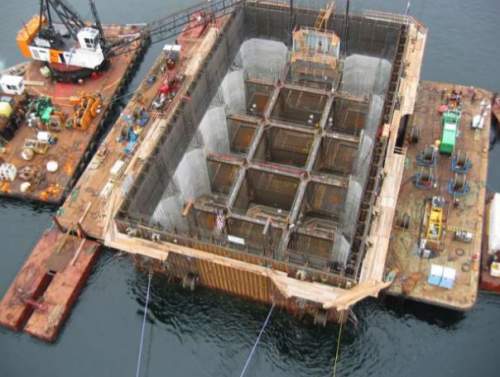The word caisson is derived from latin capsa [1] which means box or case.
In Civil Engineering, Caissons denote watertight structures which are constructed in connection with the excavation for foundations of bridges, piers, abutments in river and lake dock structure, foreshore protection, etc. The caisson remains in its pose and thus ultimately becomes as integral parts of the permanent structure. It can be made up of wood, steel or reinforced concrete, etc.

When Caisson is Required
Followings are the suitable conditions for the caisson foundation:
- When the soil contains large boulders, which obstruct the penetration of piles.
- When a massive substructure is required to extend to or below the rear bed to provide resistance against destructive forces due to floating objects and score etc.
- When the foundation is subjected to a large lateral load.
- When the depth of the water level in the river and sea is high.
- When there are river forces included in the load compositions.
- When the load is needed to carry at the end, caissons are preferred.
- When the present groundwater level is aggressive inflow, caissons are suitable.
Mechanism of caisson
Caisson is a box but with no floor underneath it. So, when we put it underwater instead of filling up with water as it is airtight, bubbles form. So as a result, we have a dirt floor from where all the water is kept out. But water is heavy so the surface of the water is exerting pressure on the caisson and try to enter the caisson. So, in order to solve this, we build a platform up in the top and a tube connecting the caisson to the platform that exerts compressed pressure into the surface of the caissons. The front pressure and the chamber pressure equalizes, therefore. The workers climb down in the box and they start digging the dirt out of it. Now if the dirt is taken out manually, all the water will come inside and drown everything. To solve this, we build a pipe full of water. Air pressure from the environment and inside pressure of the caisson keep the water intact in the pipe. Next, the workers send a bucket through the pipe and fill it with dirt and then carried back up. Thus, the workers can dig their way down the riverbed. {adselite}
Types of Caisson
There are several types of caisson foundation.
- Box Caissons
- Excavated Caissons
- Floating Caissons
- Open Caissons
- Pneumatic Caissons
- Compressed Air Caissons
- Monolithic Caissons
Box Caissons
Box caissons consist of boxes with four sides and a bottom. The top of these boxes is open. The concrete box is fabricated on the ground. Prepared box caissons are floated to the foundation location and placed pre-prepared bases. Once placed in an appropriate place, the whole void space is filled with concrete in such a way that it becomes an integrated part of the previously prepared base.
Box caissons are used for the construction of the bridge pier.
Box caissons are less costly. When it is not feasible to construct on-site types of caissons or economy is required, box caisson serves the purpose.
Excavated Caissons
These kinds of caisson are used to excavate. Cylindrical shaped, these caissons are filled with concrete.
Floating Caissons
These are prefabricated boxes filled with concrete. It is also called a floating docks.
Open Caissons
Open caissons are quite like box caissons. There are two types of open caissons. Top and bottom both open and open top-closed bottom. Soft soil is suitable for these kinds of caissons. Open Caissons are used in the formation of the pier, deep manholes, pump stations, micro-tunneling, etc.
Pneumatic Caissons
Watertight or Box caissons which are used in underwater construction are known as pneumatic caissons.
Compressed Air Caissons
This type of caissons is suitable for parched working conditions where other methods might seem inconvenient.
Monolithic Caissons
The larger size of caissons compared to others.
Construction Process
Following steps could be followed to build a caisson.
- We must set the place first for the establishment of the caisson.
- Then the first 3.7m of Caisson is pre-casted.
- Next, with the help of towboat, the caisson is floated to its location by and tie it to the caisson guide.
- After that, concrete is poured using slip forming and as concrete goes, the box becomes heavier and sinks into the water along with the caisson guide.
- Mooring cables are used to hold the caissons in place.
- When the caisson finally touches the river bottom, the mooring cables are removed.
- Finally, the cap is poured.
References
- https://www.alphadictionary.com/goodword/word/caisson

